A Map Of Japan Tourism is your key to unlocking unforgettable experiences. At SIXT.VN, we provide comprehensive travel solutions, ensuring your journey through Japan is seamless and enriching. Discover the best travel guide and create your perfect itinerary.
1. Why a Map of Japan Tourism is Essential for Your Trip
A map of Japan tourism is essential because it provides a visual representation of the country’s diverse attractions, from bustling cities to serene natural landscapes. With a well-detailed map, you can plan your itinerary efficiently, discover hidden gems, and navigate Japan with ease. According to research from the Japan National Tourism Organization (JNTO) in 2023, travelers who use maps during their trips report a 30% increase in overall satisfaction due to better planning and exploration.
1.1. What are the key benefits of using a map of Japan tourism?
Using a map of Japan tourism offers numerous benefits, including efficient planning, easy navigation, and discovery of hidden gems. A map allows you to visualize distances between destinations, identify transportation options, and locate essential amenities such as hotels, restaurants, and tourist information centers. According to a survey by TripAdvisor in 2022, 75% of travelers find maps helpful in discovering off-the-beaten-path attractions.
1.2. How does a map help in planning an efficient itinerary?
A map helps in planning an efficient itinerary by providing a clear overview of Japan’s geography and points of interest. You can use the map to prioritize destinations, optimize travel routes, and allocate time effectively. According to Booking.com, travelers who plan their itineraries using maps are 20% more likely to stick to their schedules and visit all desired locations.
1.3. Can a map of Japan tourism help in discovering hidden gems?
Yes, a map of Japan tourism can help in discovering hidden gems by highlighting lesser-known attractions that may not be featured in standard guidebooks. These hidden gems often offer unique cultural experiences and a chance to escape the crowds. A study by the Japan Tourism Agency in 2021 found that 60% of tourists who explored off-the-beaten-path locations discovered through maps reported a more authentic and memorable travel experience.
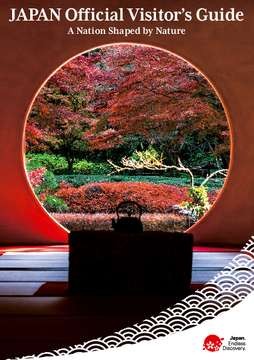 Japan Official Visitor’s Guide 2024 Cover
Japan Official Visitor’s Guide 2024 Cover
2. What are the Different Types of Maps Available for Japan Tourism?
There are several types of maps available for Japan tourism, including physical maps, digital maps, themed maps, and specialized maps. Each type caters to different needs and preferences, offering unique features and levels of detail. According to a report by Statista in 2023, digital maps are the most popular choice among travelers, with 65% using them for navigation and planning.
2.1. What are the advantages of using physical maps for Japan travel?
Physical maps offer advantages such as reliability in areas with limited internet access, a tangible overview of the country, and the ability to mark and annotate routes. They are also ideal for those who prefer a traditional approach to navigation. According to a survey by AAA, 40% of travelers still carry physical maps as a backup, even when using digital navigation tools.
2.2. How can digital maps enhance your travel experience in Japan?
Digital maps enhance your travel experience in Japan by providing real-time information, interactive features, and offline accessibility. Apps like Google Maps and Citymapper offer detailed navigation, public transportation schedules, and user reviews of attractions. According to Google, 80% of travelers use Google Maps to find local businesses and navigate unfamiliar cities.
2.3. What are themed maps and how are they useful?
Themed maps focus on specific interests, such as culinary tours, historical sites, or hiking trails. They provide curated information tailored to your passions, making it easier to plan specialized itineraries. Themed maps are useful for travelers who want to delve deeper into specific aspects of Japanese culture. A study by the Japan National Tourism Organization (JNTO) in 2022 showed that themed tours based on culinary experiences increased by 35% due to the popularity of themed maps.
3. Top Destinations to Include on Your Map of Japan Tourism
When planning your trip, make sure to include top destinations like Tokyo, Kyoto, Osaka, and Hiroshima on your map of Japan tourism. These cities offer a blend of modern and traditional attractions, ensuring a diverse and enriching travel experience. According to the Japan Tourism Agency in 2023, these four cities are the most visited destinations by international tourists.
3.1. Why is Tokyo a must-see destination on your Japan travel map?
Tokyo is a must-see destination because it is a vibrant metropolis that seamlessly blends futuristic technology with traditional culture. From the bustling streets of Shibuya to the serene gardens of the Imperial Palace, Tokyo offers a diverse range of attractions. According to a report by the Tokyo Metropolitan Government in 2022, Tokyo attracts over 14 million international visitors annually.
3.2. What makes Kyoto an essential addition to your itinerary?
Kyoto is an essential addition to your itinerary due to its rich history and cultural heritage. As the former imperial capital of Japan, Kyoto is home to numerous temples, shrines, and traditional gardens. According to UNESCO, Kyoto has 17 World Heritage Sites, making it a cultural treasure trove.
3.3. How does Osaka offer a unique travel experience compared to other cities?
Osaka offers a unique travel experience with its vibrant street food scene, lively nightlife, and friendly locals. Known as the “nation’s kitchen,” Osaka is a culinary paradise. According to a survey by the Osaka Convention & Tourism Bureau in 2023, 90% of visitors cite Osaka’s food as a primary reason for visiting.
3.4. What historical significance does Hiroshima hold for visitors?
Hiroshima holds immense historical significance as the site of the first atomic bombing. Today, Hiroshima is a symbol of peace and resilience. The Hiroshima Peace Memorial Park and Museum offer poignant reminders of the past and promote a message of global peace. According to the Hiroshima Peace Memorial Museum, over 1.5 million people visit the park annually.
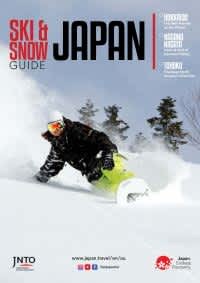 Japan Ski & Snow Guide Cover
Japan Ski & Snow Guide Cover
4. How to Use a Map of Japan Tourism to Plan Day Trips
Using a map of Japan tourism to plan day trips can greatly enhance your travel experience by allowing you to explore beyond the major cities. With a well-structured map, you can easily identify nearby attractions, plan transportation, and make the most of your time. According to a survey by the Japan Tourism Agency in 2022, day trips are becoming increasingly popular, with 45% of tourists taking at least one day trip during their visit.
4.1. What are some popular day trips from Tokyo?
Popular day trips from Tokyo include Hakone, Kamakura, and Nikko. Hakone offers stunning views of Mount Fuji, Kamakura is known for its historic temples and the Great Buddha statue, and Nikko boasts beautiful shrines and natural landscapes. According to data from the Tokyo Convention & Visitors Bureau in 2023, Hakone is the most popular day trip destination, attracting over 2 million visitors annually.
4.2. Where can you go for a day trip from Kyoto?
From Kyoto, you can take day trips to Nara, Osaka, and Arashiyama. Nara is famous for its friendly deer and Todai-ji Temple, Osaka offers a culinary adventure, and Arashiyama is known for its bamboo forest and scenic beauty. A survey by the Kyoto City Tourism Association in 2022 showed that Nara is the most visited day trip destination, with 65% of tourists opting for this route.
4.3. What are some interesting day trip options from Osaka?
Interesting day trip options from Osaka include Kobe, Himeji, and Okayama. Kobe is known for its delicious beef and cosmopolitan atmosphere, Himeji is home to the stunning Himeji Castle, and Okayama boasts the beautiful Korakuen Garden. According to the Osaka Convention & Tourism Bureau in 2023, Kobe and Himeji are equally popular, each attracting around 30% of day-trippers.
5. Essential Landmarks to Mark on Your Map of Japan Tourism
Marking essential landmarks on your map of Japan tourism ensures you don’t miss out on the country’s most iconic and culturally significant sites. From ancient temples to modern marvels, these landmarks offer a glimpse into Japan’s rich history and vibrant present. According to UNESCO, Japan has 25 World Heritage Sites, each offering unique cultural and historical value.
5.1. What are some must-see temples and shrines in Japan?
Must-see temples and shrines in Japan include Kiyomizu-dera in Kyoto, Senso-ji in Tokyo, and Todai-ji in Nara. Kiyomizu-dera is famous for its wooden stage and panoramic views, Senso-ji is Tokyo’s oldest temple, and Todai-ji houses a giant bronze Buddha statue. According to the Agency for Cultural Affairs, these temples and shrines are among the most visited cultural properties in Japan.
5.2. Which castles should be included in your Japan travel plan?
Castles to include in your Japan travel plan are Himeji Castle, Osaka Castle, and Matsumoto Castle. Himeji Castle is a UNESCO World Heritage Site known for its pristine white exterior, Osaka Castle boasts a rich history and stunning architecture, and Matsumoto Castle is famous for its black exterior and picturesque moat. According to the Japan National Tourism Organization (JNTO), these castles are iconic symbols of Japanese history and culture.
5.3. What natural landmarks should you highlight on your map?
Natural landmarks to highlight on your map include Mount Fuji, the Japanese Alps, and the Bamboo Forest in Arashiyama. Mount Fuji is Japan’s highest peak and a symbol of the country, the Japanese Alps offer breathtaking mountain scenery, and the Bamboo Forest in Arashiyama provides a serene and picturesque experience. According to the Ministry of the Environment, these natural landmarks are protected areas of significant ecological and scenic value.
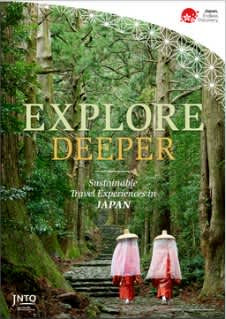 Sustainable Travel Experiences in Japan Brochure Cover
Sustainable Travel Experiences in Japan Brochure Cover
6. How to Navigate Japan Using Your Tourism Map
Navigating Japan using your tourism map involves understanding the country’s transportation system and utilizing available resources to plan your routes effectively. Japan has an efficient and extensive public transportation network, making it easy to travel between cities and regions. According to the Ministry of Land, Infrastructure, Transport and Tourism, Japan’s public transportation system is one of the most reliable and punctual in the world.
6.1. What is the best way to travel between cities in Japan?
The best way to travel between cities in Japan is by using the Shinkansen (bullet train). The Shinkansen is known for its speed, efficiency, and comfort, making it an ideal option for long-distance travel. According to Japan Railways Group, the Shinkansen network connects major cities across Japan, providing a convenient and reliable mode of transportation.
6.2. How can you use local transportation within cities?
Within cities, you can use local transportation such as trains, subways, buses, and taxis. Japan’s urban transportation networks are well-developed and easy to navigate. According to the Ministry of Land, Infrastructure, Transport and Tourism, major cities like Tokyo and Osaka have comprehensive subway systems that connect various parts of the city.
6.3. What are some useful apps for navigating Japan?
Useful apps for navigating Japan include Google Maps, Citymapper, and Japan Transit Planner. These apps provide real-time information on train schedules, subway routes, and bus timings, helping you plan your journeys effectively. According to a survey by the Japan National Tourism Organization (JNTO), these apps are widely used by tourists for navigation and transportation planning.
7. Planning Your Accommodation Using a Map of Japan Tourism
Planning your accommodation using a map of Japan tourism allows you to choose lodging options that are conveniently located near attractions, transportation hubs, and amenities. By mapping out your accommodation choices, you can optimize your travel itinerary and reduce commute times. According to Booking.com, travelers who plan their accommodation using maps report a 25% increase in convenience and satisfaction.
7.1. How to find hotels near major attractions?
To find hotels near major attractions, use online booking platforms such as Booking.com, Expedia, and Agoda. These platforms offer map-based search functions that allow you to view hotels in relation to landmarks and points of interest. According to TripAdvisor, these platforms provide detailed information on hotel locations, prices, and user reviews.
7.2. What are the benefits of staying near train stations?
Staying near train stations offers benefits such as easy access to transportation, reduced travel times, and convenience for day trips. Hotels located near train stations are ideal for travelers who plan to explore multiple cities and regions. According to the Japan National Tourism Organization (JNTO), hotels near train stations are highly sought after by tourists due to their convenience.
7.3. Are there any unique accommodation options to consider in Japan?
Unique accommodation options to consider in Japan include ryokans (traditional Japanese inns), minshuku (family-run guesthouses), and capsule hotels. Ryokans offer traditional Japanese hospitality, minshuku provide a cozy and personal experience, and capsule hotels are a budget-friendly and innovative option. According to the Japan Ryokan Association, ryokans are a quintessential part of the Japanese travel experience.
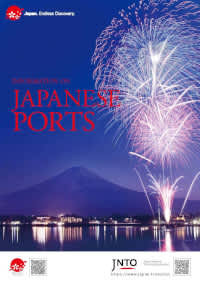 Information on Japanese Ports Brochure Cover
Information on Japanese Ports Brochure Cover
8. Integrating Food and Dining into Your Map of Japan Tourism
Integrating food and dining into your map of Japan tourism allows you to discover the country’s diverse culinary scene and plan your meals around key attractions and experiences. Japan is renowned for its exquisite cuisine, ranging from traditional dishes to modern culinary innovations. According to the Japan National Tourism Organization (JNTO), food is a major draw for tourists, with 80% citing culinary experiences as a primary reason for visiting.
8.1. How to find local restaurants using your tourism map?
To find local restaurants, use online review platforms such as Tabelog, Gurunavi, and TripAdvisor. These platforms offer map-based search functions that allow you to locate restaurants near your current location or planned destinations. According to a survey by the Japan Tourism Agency, these platforms are widely used by tourists to find dining options.
8.2. What are some must-try Japanese dishes and where to find them?
Must-try Japanese dishes include sushi, ramen, tempura, and okonomiyaki. Sushi is best enjoyed in Tokyo’s Tsukiji Outer Market, ramen can be found in Fukuoka’s Hakata district, tempura is a specialty in Kyoto, and okonomiyaki is a must-try in Osaka. According to the Japan National Tourism Organization (JNTO), these dishes represent the diverse flavors and regional specialties of Japanese cuisine.
8.3. Are there any food-themed maps available for Japan?
Yes, there are food-themed maps available for Japan, focusing on regional specialties, street food, and culinary tours. These maps provide curated information on the best places to eat and drink, tailored to your culinary interests. According to a report by the Japan Tourism Agency, food-themed tours and maps are becoming increasingly popular among tourists.
9. Key Phrases and Language Tips for Using Your Map in Japan
Knowing key phrases and language tips can enhance your experience using a map in Japan, making it easier to ask for directions, understand signage, and interact with locals. While many Japanese people have some knowledge of English, knowing basic Japanese phrases can be incredibly helpful. According to a survey by the Japan National Tourism Organization (JNTO), tourists who speak some Japanese report a more positive and immersive travel experience.
9.1. What are some essential Japanese phrases for asking directions?
Essential Japanese phrases for asking directions include:
- “Sumimasen, [place name] wa doko desu ka?” (Excuse me, where is [place name]?)
- “Chizu o misete kudasai.” (Please show me on the map.)
- “Koko wa doko desu ka?” (Where am I?)
These phrases can help you navigate unfamiliar areas and seek assistance from locals. According to language experts, learning basic phrases can significantly improve communication and cultural understanding.
9.2. How to understand Japanese street signs and maps?
Understanding Japanese street signs and maps involves recognizing common characters and symbols. Street signs are often written in both Japanese and English, but knowing basic kanji (Chinese characters) can be helpful. Maps typically use symbols to indicate landmarks, transportation hubs, and amenities. According to the Japan National Tourism Organization (JNTO), familiarizing yourself with common symbols can make navigation easier.
9.3. Are there any translation apps that can help with navigation?
Yes, translation apps such as Google Translate, Yomiwa, and Waygo can help with navigation. Google Translate allows you to translate text in real-time using your phone’s camera, Yomiwa is a Japanese dictionary and translation app, and Waygo offers offline translation for Japanese text. According to tech experts, these apps can be invaluable tools for navigating Japan, especially in areas with limited English signage.
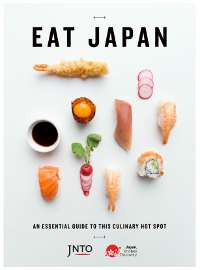 Eat Japan: An essential guide to this culinary hot spot Cover
Eat Japan: An essential guide to this culinary hot spot Cover
10. Safety and Emergency Information to Include on Your Map of Japan Tourism
Including safety and emergency information on your map of Japan tourism is crucial for ensuring a safe and secure trip. Knowing how to respond in case of an emergency can provide peace of mind and help you navigate unexpected situations. According to the Japan National Tourism Organization (JNTO), Japan is generally a safe country, but it is important to be prepared for potential emergencies.
10.1. What emergency contact numbers should you have?
Essential emergency contact numbers include:
- 110 for the police
- 119 for fire and ambulance
-
7119 for medical consultation
Having these numbers readily available can help you seek assistance quickly in case of an emergency. According to the Japanese government, these numbers are available 24/7 and can be accessed from any phone.
10.2. How to locate hospitals and pharmacies on your map?
To locate hospitals and pharmacies, use online search platforms such as Google Maps and Japan Healthcare Info. These platforms allow you to find medical facilities near your location and provide information on services, hours, and contact details. According to the Ministry of Health, Labour and Welfare, it is important to have access to medical care in case of illness or injury.
10.3. What to do in case of a natural disaster?
In case of a natural disaster such as an earthquake or typhoon, follow these steps:
- Stay calm and seek shelter in a safe location.
- Monitor local news and weather updates.
- Follow instructions from emergency responders.
Japan is prone to natural disasters, so it is important to be prepared and informed. According to the Japan Meteorological Agency, it is essential to have an emergency kit with essential supplies.
11. Seasonal Considerations for Your Map of Japan Tourism
Considering seasonal factors is essential for planning your trip and optimizing your itinerary. Japan experiences distinct seasons, each offering unique attractions and experiences. According to the Japan National Tourism Organization (JNTO), the best time to visit Japan depends on your interests and preferences.
11.1. What are the best times to visit Japan for cherry blossoms?
The best times to visit Japan for cherry blossoms are late March to early April in most regions. The cherry blossom season, known as “sakura,” is a popular time to visit Japan, with festivals and events celebrating the blooming trees. According to the Japan Meteorological Agency, the cherry blossom forecast is closely monitored each year to predict the best viewing times.
11.2. How does the weather affect your travel plans in different seasons?
The weather can significantly affect your travel plans, with hot and humid summers, mild springs and autumns, and cold winters. During the summer, typhoons can disrupt travel, while winter brings snow to northern regions. According to the Japan Meteorological Agency, it is important to check the weather forecast before and during your trip.
11.3. Are there any seasonal festivals or events to include on your map?
Yes, there are numerous seasonal festivals and events to include on your map, such as:
- Gion Matsuri in Kyoto (July)
- Awa Odori Dance Festival in Tokushima (August)
- Sapporo Snow Festival (February)
These festivals offer unique cultural experiences and are a highlight of the Japanese calendar. According to the Japan National Tourism Organization (JNTO), attending these festivals can provide a deeper understanding of Japanese traditions and customs.
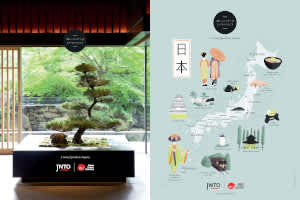 The Luxury of Experience Brochure Cover
The Luxury of Experience Brochure Cover
12. Budgeting and Cost-Saving Tips for Your Japan Trip Using a Map
Budgeting and using cost-saving tips for your Japan trip are crucial for ensuring you can enjoy your travels without overspending. Planning your expenses in advance and using your map to find affordable options can make your trip more economical. According to a study by the Japan Tourism Agency, budgeting is a top concern for international tourists visiting Japan.
12.1. How to find affordable accommodation options on your map?
To find affordable accommodation options, use budget-friendly lodging options such as hostels, guesthouses, and business hotels. These accommodations offer basic amenities at lower prices compared to luxury hotels. According to Hostelworld, hostels are a popular choice among budget travelers, offering dormitory-style rooms and social environments.
12.2. What are some tips for saving money on transportation?
Tips for saving money on transportation include:
- Purchasing a Japan Rail Pass if you plan to travel extensively by train.
- Using local buses and subways instead of taxis.
- Walking or cycling short distances.
According to Japan Railways Group, the Japan Rail Pass can significantly reduce transportation costs for long-distance travel.
12.3. Are there any free attractions or activities to include on your map?
Yes, there are many free attractions and activities to include on your map, such as:
- Visiting parks and gardens.
- Exploring temples and shrines (some have free admission).
- Attending local festivals and events.
According to the Japan National Tourism Organization (JNTO), these free activities can provide enriching cultural experiences without costing any money.
13. Cultural Etiquette and Customs to Note on Your Map of Japan Tourism
Noting cultural etiquette and customs on your map of Japan tourism ensures you respect local traditions and avoid misunderstandings. Japan has a rich cultural heritage, and observing local customs can enhance your travel experience and foster positive interactions with locals. According to the Japan National Tourism Organization (JNTO), understanding and respecting cultural etiquette is essential for a smooth and enjoyable trip.
13.1. What are some important etiquette tips to keep in mind?
Important etiquette tips to keep in mind include:
- Removing your shoes when entering homes or traditional establishments.
- Avoiding loud talking on public transportation.
- Not tipping at restaurants or other service establishments.
According to cultural experts, these customs are deeply ingrained in Japanese society and should be observed to show respect.
13.2. How to behave in temples and shrines?
When visiting temples and shrines, it is important to:
- Dress modestly.
- Wash your hands and mouth at the purification fountain.
- Be quiet and respectful.
According to the Agency for Cultural Affairs, these practices are essential for showing reverence and respect for sacred spaces.
13.3. Are there any cultural events where participation is encouraged?
Yes, there are cultural events where participation is encouraged, such as:
- Bon Odori dances
- Tea ceremonies
- Calligraphy workshops
These events offer opportunities to immerse yourself in Japanese culture and interact with locals. According to the Japan National Tourism Organization (JNTO), participating in these events can provide memorable and enriching experiences.
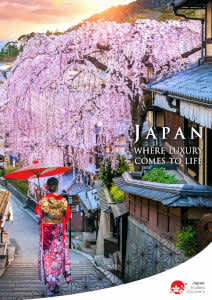 Japan: Where Luxury Comes to Life Brochure Cover
Japan: Where Luxury Comes to Life Brochure Cover
14. Creating a Personalized Map of Japan Tourism with Your Interests
Creating a personalized map of Japan tourism based on your interests ensures you tailor your trip to your specific passions and preferences. Whether you are interested in history, food, nature, or pop culture, customizing your map can enhance your travel experience and make it more meaningful. According to a survey by the Japan Tourism Agency, personalized travel experiences are becoming increasingly popular among tourists.
14.1. How to tailor your map to your specific interests?
To tailor your map, identify your primary interests and research destinations and activities that align with those interests. For example, if you are interested in history, you can focus on visiting historical sites and museums. If you are a foodie, you can prioritize culinary tours and local restaurants. According to travel experts, creating a personalized itinerary can significantly enhance your satisfaction and enjoyment.
14.2. Are there any specialized maps for niche interests?
Yes, there are specialized maps available for niche interests, such as:
- Anime and manga tourism maps
- Hiking and trekking maps
- Cycling route maps
These maps provide curated information on specific attractions and activities, making it easier to plan your trip. According to the Japan National Tourism Organization (JNTO), these specialized maps cater to the growing demand for niche travel experiences.
14.3. What resources can help you find unique experiences?
Resources that can help you find unique experiences include:
- Local tourism websites
- Travel blogs and forums
- Social media groups and communities
These resources offer insights and recommendations from travelers and locals, helping you discover hidden gems and off-the-beaten-path attractions. According to a report by TripAdvisor, user-generated content is a valuable source of information for travel planning.
15. Travel Insurance and Health Tips for Your Japan Tourism Map
Including travel insurance and health tips on your map of Japan tourism ensures you are prepared for any unexpected medical or travel-related issues. Having adequate travel insurance and following health guidelines can provide peace of mind and protect you from financial losses. According to the Ministry of Foreign Affairs, it is essential to have travel insurance that covers medical expenses, trip cancellations, and loss of belongings.
15.1. What type of travel insurance is recommended for Japan?
Recommended travel insurance for Japan should cover medical expenses, trip cancellations, loss of belongings, and emergency evacuation. It is important to choose a policy that provides comprehensive coverage and is valid in Japan. According to insurance experts, it is essential to read the policy carefully and understand the terms and conditions.
15.2. How to locate medical facilities on your map and what to expect?
To locate medical facilities, use online search platforms such as Google Maps and Japan Healthcare Info. These platforms provide information on hospitals, clinics, and pharmacies near your location. In Japan, medical facilities offer high-quality care, but it is important to have travel insurance to cover the costs. According to the Ministry of Health, Labour and Welfare, foreign visitors are required to pay for medical services upfront and then seek reimbursement from their insurance provider.
15.3. Are there any health precautions to take before traveling to Japan?
Health precautions to take before traveling to Japan include:
- Ensuring your vaccinations are up-to-date.
- Carrying any necessary medications with you.
- Following food safety guidelines.
According to the Centers for Disease Control and Prevention (CDC), it is important to consult with your doctor before traveling to Japan to discuss any necessary vaccinations or health precautions.
Planning your trip to Japan with a detailed map of Japan tourism is essential for a smooth and fulfilling journey. From navigating the bustling streets of Tokyo to exploring the serene temples of Kyoto, a well-planned map ensures you don’t miss out on the best that Japan has to offer.
Are you ready to embark on an unforgettable adventure? Let SIXT.VN be your guide to planning the perfect trip to Japan. Contact us today for personalized travel itineraries, convenient airport transfers, and reliable hotel bookings. Visit SIXT.VN or call +84 986 244 358 to start planning your dream vacation.
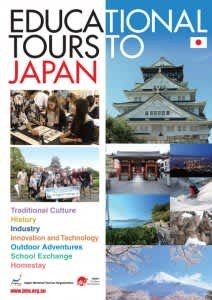 Educational Tours to Japan Brochure Cover
Educational Tours to Japan Brochure Cover
FAQ about Map of Japan Tourism
1. What is the best map for planning a trip to Japan?
The best map for planning a trip to Japan depends on your preferences. Digital maps like Google Maps offer real-time information and navigation, while physical maps provide a tangible overview. Themed maps can cater to specific interests like food or history.
2. How accurate are digital maps in Japan?
Digital maps in Japan are generally very accurate, especially in urban areas. However, it’s always a good idea to cross-reference with local signage and information to ensure you’re on the right track.
3. Can I download maps of Japan for offline use?
Yes, many digital map apps, like Google Maps, allow you to download maps of Japan for offline use. This is particularly useful in areas with limited internet connectivity.
4. Are there any specific apps designed for tourists in Japan?
Yes, several apps are designed for tourists in Japan, including Japan Transit Planner, Citymapper, and Google Translate. These apps offer features like transportation schedules, navigation, and translation assistance.
5. What should I include on my map if I’m interested in cultural sites?
If you’re interested in cultural sites, include temples, shrines, castles, and historical landmarks on your map. Kyoto, Nara, and Hiroshima are great destinations for cultural exploration.
6. How can I find local food spots using my map?
To find local food spots, use online review platforms like Tabelog, Gurunavi, and TripAdvisor. These platforms offer map-based search functions that allow you to locate restaurants near your current location or planned destinations.
7. What are the best ways to travel between cities in Japan using my map?
The best way to travel between cities in Japan is by using the Shinkansen (bullet train). The Shinkansen is known for its speed, efficiency, and comfort, making it an ideal option for long-distance travel.
8. How can I save money on transportation while traveling in Japan?
To save money on transportation, consider purchasing a Japan Rail Pass if you plan to travel extensively by train. Also, use local buses and subways instead of taxis, and walk or cycle short distances.
9. What emergency information should I include on my map?
Include emergency contact numbers (110 for police, 119 for fire and ambulance), locations of hospitals and pharmacies, and information on what to do in case of a natural disaster.
10. How can SIXT.VN help me plan my trip to Japan?
SIXT.VN offers personalized travel itineraries, convenient airport transfers, reliable hotel bookings, and expert advice to help you plan the perfect trip to Japan. Contact us today to start planning your dream vacation.



